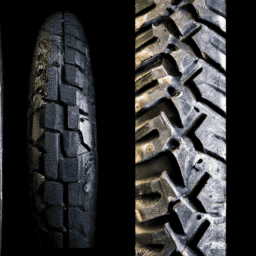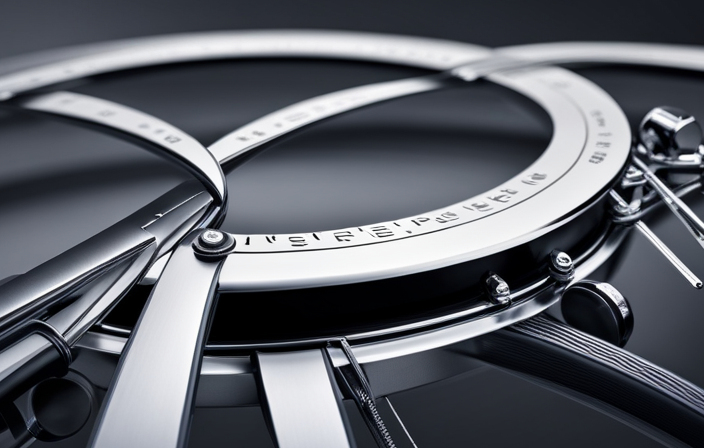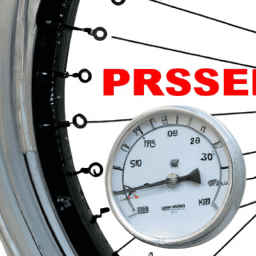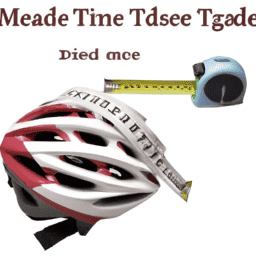As a passionate cyclist, I recognize the significance of keeping my bicycle in top condition. Among the essential parts that need regular care are the tires. Tires play a crucial role in offering grip, cushioning impacts, and ensuring stability during rides.
However, like any other part of the bike, the tires have a shelf life, and it’s crucial to know when it’s time to replace them to ensure optimal performance and safety.
In this article, we will delve into the factors that affect the lifespan of bicycle tires, signs that indicate it’s time to replace them, how to choose the right replacement tires, tips to prolong their life, and the importance of regularly replacing your bicycle tires. Whether you’re a professional cyclist, recreational rider, or a beginner, understanding these aspects will help you make informed decisions and get the most out of your cycling experience.
So, let’s get started!
Key Takeaways
- Signs that indicate it’s time to replace bicycle tires include worn tread depth, sidewall damage, punctures, cuts, and loss of traction.
- To maintain optimal tire performance and longevity, it’s important to regularly check and adjust tire pressure, choose the right replacement tires based on riding style and terrain, and regularly maintain and inspect tires.
- Tire tread depth and wear bars are important indicators of when it’s time to replace tires, and sidewall damage can cause a blowout while riding.
- Choosing the right tires based on durability, grip, rolling resistance, compatibility with bike rim size, and environmental impact is crucial for enhancing riding experience and ensuring safety, and cost-effective options are available in the market.
Factors Affecting the Lifespan of Bicycle Tires
The longevity of bike tires can be influenced by various factors, including but not limited to, road conditions, tire pressure, and the quality of the tire itself. These factors affect the durability of the tire and the impact of weather on the lifespan of the tire.
Prolonged exposure to UV rays, extreme cold or hot temperatures, and moisture can all weaken the tire’s structure and cause it to deteriorate faster. Road conditions also play a significant role in determining how long your bike tires will last.
Potholes, sharp rocks, and other debris can cause punctures or cuts in the tire, leading to premature wear and tear. The frequency and intensity of use can also affect the lifespan of the tire.
As the tire wears down, the tread will become thinner, and the tire will become more susceptible to punctures and other damage. Knowing the factors that affect tire durability is essential in determining when to replace your bike tires.
Signs That Indicate It’s Time to Replace Your Tires
I want to talk about the signs that indicate it’s time to replace your bicycle tires.
When it comes to wear and tear, it’s important to keep an eye on the tread depth.
Punctures and cuts can also be a major concern, as they compromise the integrity of the tire and can lead to blowouts.
Lastly, a loss of traction can indicate that the tire is no longer able to grip the road properly, which can be a major safety issue.
Wear and Tear
You’re going to feel the difference in your ride when your bike tires start to wear down, so it’s important to keep an eye on them and replace them when needed.
One way to check for wear and tear is to evaluate the tread depth. Tread depth is the amount of rubber on the tire that comes in contact with the ground. To check the tread depth, use a tire depth gauge or simply look at the tire itself. If the tread is worn down to the wear bars, it’s time to replace the tire. The wear bars are small raised bars that run across the tire tread. If the tread is level with the wear bars, it’s time to replace the tire.
Another thing to evaluate when checking for wear and tear is the sidewall damage. The sidewall is the area of the tire that runs from the bead to the tread. If the sidewall is damaged, it can cause a blowout while riding. Look for cracks, cuts, punctures, or bulges on the sidewall. If any of these are present, it’s time to replace the tire.
Remember, a damaged tire can be dangerous to ride on. With wear and tear in mind, let’s move on to the next section about punctures and cuts.
Punctures and Cuts
When you’re out on a ride, it’s important to watch out for sharp objects on the road that can cause punctures or cuts in your bike’s rubber. Here are some preventive measures to take to avoid these mishaps:
-
Check your tires before each ride. Look for any cuts, punctures, or signs of wear that may need attention.
-
Avoid riding over debris on the road. It’s best to steer clear of sharp objects like broken glass, nails, or rocks.
-
Use tire sealant to prevent punctures. This can be applied before a ride and will seal any small holes that may occur during your ride.
-
Carry a repair kit with you. In case of a puncture or cut, having a repair kit handy can save you from being stranded.
If you do happen to get a puncture or cut in your tire, there are repairing options available. Some people choose to patch their tires themselves using a kit, while others prefer to take their bike to a professional. It’s important to note that if a cut or puncture is too large, the tire may need to be replaced entirely.
Loss of traction is another issue to be mindful of when it comes to replacing bicycle tires.
Loss of Traction
Losing traction while riding can be a scary experience, especially if you’re going downhill or taking a sharp turn. It can happen when the road surface is wet, slippery, or covered in debris. A loss of traction can also occur when your tires are worn out, and the tread is no longer providing sufficient grip.
To improve grip, it’s important to maintain the correct tire pressure. Underinflated tires can reduce traction and make it harder to control your bike. On the other hand, overinflated tires can reduce the size of the contact patch between the tire and the road, which can also affect traction. Checking your tire pressure regularly and adjusting it as needed can help you maintain optimal grip and control.
As you can see, tire pressure and tread are critical factors when it comes to maintaining good traction on your bicycle. However, if your tires are showing signs of wear and tear, it may be time to consider replacing them altogether.
So, how do you choose the right replacement tires? Let’s find out.
How to Choose the Right Replacement Tires
Selecting the perfect replacement tires for your bicycle can be a real game-changer, like finding the perfect pair of shoes for a marathon. It’s important to choose the right type of tire based on your riding style, terrain, and weather conditions. There are several types of tires available in the market, including road, mountain, hybrid, and touring tires. Each type of tire has its own unique features and benefits, so it’s important to choose the one that suits your needs the best.
Another important factor to consider when choosing replacement tires is the tire size guide. The size of your tire is indicated on the sidewall of the tire and is expressed in a series of numbers and letters. It’s important to choose a tire that matches the size of your current tire to ensure a proper fit. Additionally, you may want to consider other factors such as tread pattern, durability, and puncture resistance when choosing replacement tires. By taking the time to select the right replacement tires, you can ensure a smoother and more enjoyable riding experience.
To prolong the life of your bicycle tires, there are several tips you can follow. One of the most important things is to maintain proper tire pressure, which can help prevent premature wear and tear. Additionally, regularly inspecting your tires for signs of damage or wear can help you identify potential issues before they become major problems. By following these tips and taking proper care of your tires, you can enjoy a longer lifespan and better performance from your bicycle tires.
Tips to Prolong the Life of Your Bicycle Tires
I want to share some tips that’ve helped me extend the life of my bicycle tires.
First and foremost, proper inflation is crucial. Maintaining the recommended pressure range will not only prevent flats but also improve performance.
Secondly, regular maintenance such as cleaning, inspecting, and lubricating the tires can significantly increase their lifespan.
Lastly, avoiding hazards like glass, sharp rocks, and potholes can prevent punctures and cuts that could shorten the life of your tires.
Proper Inflation
Maintaining proper inflation levels on your bicycle tires is crucial for optimal performance and longevity. Here are three reasons why checking pressure is important:
-
Safety: Overinflation risks can cause your tires to blow out unexpectedly. This can be dangerous, especially if you’re traveling downhill or at high speeds.
-
Efficiency: Properly inflated tires roll more smoothly, which means less resistance and more efficient riding. This can save you energy and make your ride more enjoyable.
-
Longevity: Overinflated or underinflated tires can wear out faster than tires that are properly inflated. By keeping your tires at the correct pressure, you can extend their lifespan and save money in the long run.
Regular maintenance is key to keeping your bike in top condition. By checking your tire pressure regularly, you can ensure that your tires are performing at their best.
Regular Maintenance
Keeping up with regular maintenance is the key to ensuring your bike stays in top condition, so you can avoid any unexpected breakdowns and enjoy a smooth ride. This includes checking the pressure of your tires regularly, as it can significantly impact the performance and lifespan of your tires. A simple pressure gauge can be used to check the pressure, and it’s essential to make sure it’s within the recommended range specified on the sidewall of the tire. Riding on underinflated tires can cause pinch flats and premature wear, while overinflated tires can lead to a harsh ride and decreased traction.
Another essential component of regular maintenance is proper cleaning, which can help prolong the life of your tires. Dirt and debris can accumulate on your tires, leading to increased wear and tear. A quick wipe down with a damp cloth can remove any dirt and grime, and a mild detergent can be used for tougher stains. It’s also important to inspect the tires for any signs of damage, such as cuts or punctures, which can compromise the integrity of the tire and lead to a blowout. By regularly checking the pressure and keeping your tires clean and free of damage, you can ensure they last longer and perform better on your rides.
Ensuring proper maintenance is just one way to avoid unexpected hazards on your bike rides. By following these steps, you can prevent any issues that might arise from improper tire care and keep yourself safe on the road.
Avoiding Hazards
As a responsible cyclist, I know that regular maintenance is crucial in ensuring my safety while riding. However, even with careful maintenance, I need to be mindful of potential hazards that can damage my bicycle tires. Preventing damage is key to avoiding unexpected blowouts or flats while on the road.
Safe riding practices also play a significant role in avoiding tire damage. I make sure to steer clear of potholes, debris, and other obstacles on the road that could puncture or damage my tires. I also avoid overloading my bike with heavy loads, as this can put undue stress on my tires.
By being proactive in preventing damage and practicing safe riding habits, I can extend the lifespan of my tires and reduce the likelihood of needing to replace them prematurely.
It’s important to note that even with proper care, bicycle tires have a limited lifespan. In the next section, I’ll discuss the importance of regularly replacing your bicycle tires to maintain optimal performance and safety while riding.
Importance of Regularly Replacing Your Bicycle Tires
Regularly replacing your bicycle tires is crucial for a safe and enjoyable ride. Not only will worn-out tires greatly increase your risk of accidents, but they also affect the overall performance of your bike.
As a cyclist, you must understand the importance of timely replacement to ensure that you are always riding on high-quality tires. When it comes to replacing your bicycle tires, there are several cost-effective options available in the market.
Look for tires that offer a good balance between durability, grip, and rolling resistance, and make sure that they are compatible with your bike’s rim size. Additionally, it’s essential to consider the environmental impact of your decision.
Opting for eco-friendly tires made from recycled materials or those that can be recycled at the end of their life cycle is a responsible choice that benefits both you and the environment.
Remember, investing in good quality tires is a worthy investment that guarantees your safety and enhances your riding experience.
Regularly replacing your bicycle tires is a crucial aspect of bike maintenance. It’s essential to choose the right tires that provide a good balance between cost, durability, and environmental impact. By doing so, you can ensure that your bike is always in top condition, providing you with a safe and enjoyable ride every time you hit the road.
Frequently Asked Questions
Can I replace just one tire or do I need to replace both at the same time?
Yes, it is possible to replace only one tire. Cost may be less if only one tire is replaced, but it is important to consider overall wear and tear. Replacing both tires simultaneously may be a better long-term investment.
Is there a recommended brand or type of tire for certain types of terrain or riding styles?
When it comes to choosing the right tire for your riding style and terrain, there are top rated options to consider. Each has its pros and cons, so it’s important to do your research and choose wisely.
How often should I check the tire pressure and what is the recommended pressure for my bike tires?
I check my bike tire pressure before every ride. The recommended PSI for my bike tires is printed on the sidewall of the tire. It’s important to maintain proper tire pressure for optimal performance and to prevent flats.
Are there any eco-friendly options for replacing bicycle tires?
I am interested in eco-friendly tire options for my bike. Sustainability concerns drive my search for options made with non-toxic materials and recycled content. I need to research brands that offer these features.
Can I patch or repair a punctured tire or is it safer to replace it completely?
Patching a punctured bike tire can be advantageous as it’s cheaper than replacing it completely. However, it’s important to assess the extent of the damage and consider the cost comparison of repair vs replacement.
Conclusion
In conclusion, as a cyclist, it’s essential to know when to replace your bicycle tires to ensure your safety and improve your riding experience.
By understanding the factors that influence the lifespan of your tires and spotting the signs of wear and tear, you can make informed decisions about when to replace them.
Remember to choose the right replacement tires, depending on your cycling needs and budget.
Furthermore, taking care of your tires can prolong their lifespan and save you money in the long run.
Simple maintenance practices such as keeping your tires properly inflated, avoiding harsh riding conditions, and storing your bike indoors can significantly improve the durability of your tires.
So, keep an eye on your tires, and don’t hesitate to replace them when necessary to enjoy a smooth and safe ride.
Happy cycling!









